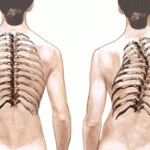
What is scoliosis in adults? This can be explained best by first asking, “What is scoliosis?” Scoliosis is an abnormal lateral curvature of the spine. It is usually diagnosed in childhood or early adolescence but can also be diagnosed in adulthood. You see, the normal curve of the spine occurs at the cervical, thoracic and lumbar regions in the “sagittal” plane. These natural curves position the head over the pelvis and work as shock absorbers to distribute mechanical stress during movement.
If you were diagnosed with scoliosis and you’re already an adult, it is distinctive from childhood scoliosis because the underlying causes and goals of treatment differ from patients who have already reached skeletal maturity.
Scoliosis In Adults Can Be Divided Into Three Categories:
- Adult scoliosis patients who are surgically treated as adoloscents
- Adults who did not receive treatment when they were younger
- Adults with degenerative scoliosis
What Is Degenerative Scoliosis?
This condition occurs frequently in the lumbar spine or the lower back, and it usually affects people aged 65 and older. Oftentimes, it is accompanied by spinal stenosis or narrowing of the spinal canal which pinches the spinal nerves and makes it difficult for them to function normally. The back pain associated with this particular type of scoliosis in adults usually begins gradually and is often linked with activity.
Signs/Symptoms Of Scoliosis:
- Uneven shoulders
- Head is not directly centered above the pelvis
- One or both hips are raised or are unusually high
- Rib cages are at different heights
- Uneven waist
- Appearance or texture of the skin overlying the spine changes like dimples, hairy patches and color abnormalities
- The entire body leans to one side
If your doctor suspects that you have scoliosis after performing a physical examination, he or she will order radiological tests to confirm the diagnosis. For scoliosis in adults, X-rays are often recommended once every 5 years, unless symptoms are getting progressively worse.
There is a 20-year study that states that almost 40% of patients who have scoliosis experienced a progression, 10% showed a very significant progression while the remaining 30% experienced a very mild progression, usually less than one degree per year.
The progression of the curve depends on factors like the age of diagnosis, age and outcome of original treatment, and severity and location of the curvature.
Adults who were treated as children may need revision surgery if they were treated 20-30 years ago. This was before major advances in spinal surgery procedures were implemented.
How Do You Treat Scoliosis In Adults?
- Consult your doctor if you experience the symptoms listed above.
- Go through a series of diagnostic tests to determine if you have scoliosis
- Evaluate your non-surgical treatment options first like moist heat, over-the-counter prescription anti-inflammatory and pain medicines, moderate exercise and physical injection therapies.
- You can consider surgery if the curve is in the middle of your back (thoracic), exceeds 50 degrees and is accompanied by constant pain.
- Review all your treatment options with your doctor to determine the best course of action for your condition.
- Visit your doctor every 5 years to have your condition re-evaluated.








